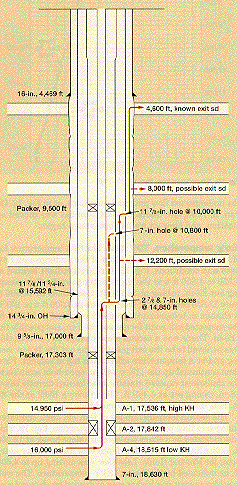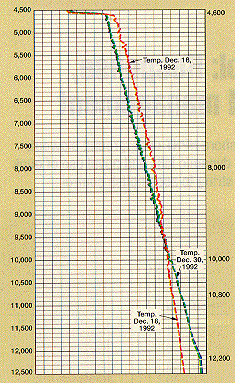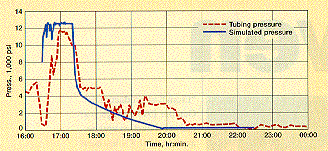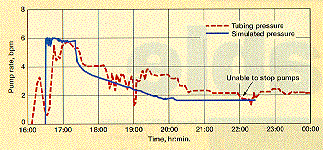![]()
Well History | Dynamic Kill Plan | Initial Gunk Squeezes | Re-initiation of Flow | Final Gunk Squeeze | Next Article | |
 Part 8-HPHT Case History: Control of an offshore HPHT underground
blowout. Lessons were learned as to limitations of dynamic kills and novel use of gunk
squeezes with a 1 1/4-in. snubbing string to accomplish control
Part 8-HPHT Case History: Control of an offshore HPHT underground
blowout. Lessons were learned as to limitations of dynamic kills and novel use of gunk
squeezes with a 1 1/4-in. snubbing string to accomplish control
Dick Gloger, Drilling Manager, CNG Producing Co.,
L. Flak, former Wright, Boots & Coots employee.
A fourth gunk squeeze was successful in sealing off annuli behind 2Y8-in. tubing located in CNG Producing Co.'s South Timbalier 76 Well F-1. This allowed bullheading gas back into the Big A sands with 18.5-ppg mud and killing the under ground blowout on Feb. 14, 1993. A 20-bbl cement plug was placed below 15,800 ft to permanently isolate A sands from the hole in the 2-7/8 in. at 14,829 ft. A pressure-temperature log run on Feb. 19, 1993, confirmed that there was no longer any flow in the wellbore. The following case history outlines steps taken to kill this high-pressure, high-temperature (HPHT) well's underground blowout.
Well F-1 is a vertical well located on a single tripod jacket in 66-ft water. The well was first put on production from the A-4 sand in January 1990. The A-1 was perforated and commingled with the A-4 in May 1991. On Aug. 20, 1992, the well was shut in for Hurricane Andrew. Prior to this shutdown, the well was producing from Big A-1 (17,536 to 17,566 ft) and Big A-4 (18,515 to 18,560 ft) perforations, with the bulk of the production from Big A-1. Prior to the shut-in, the well was producing 15 MMcfgd, 1,108 bopd and 13 bwpd, at 8,550 psi FTP.
The last shut-in pressure prior to the shut-in was 11,300 psi. Annuli pressures just prior to shut-in were: 7%-in., 3,300 psi; 11-7/8-in., 4,500 psi; 16-in., 0 psi. After Hurricane Andrew, the 7-5/8 in. annulus pressure had increased to 6,200 psi; the well remained shut in because of damage to the local pipeline network.
On Nov. 4, 1992, excessive pressure of 10,400 psi was discovered on the 11/s-in. casing during a daily well check. The 2-7/8 in. tubing and 7-in. production casing had ruptured below a packer set at 9,500 ft some time prior to this pressure development. On Nov. 16 and 17, attempts were made to pump into the 11/8-in. without success. On Nov. 19, a combination noise, pressure and temperature log was run to 17,657 ft. Underground flow to 4,600 ft was discovered, with flow exiting the 2-7/8 in. at 14,289 ft.
On Nov. 23, 1992, a spinner log measured a sudden increase in well flow, with a concurrent decrease in flowing BHP. This indicated a deteriorating well condition. On Dec. 30, 1992, additional production logs were run to map the underground flow path and conditions, as in Fig. 18. On Jan. 9, 1993, the Odeco Ocean Columbia was moved on location, and blowout control operations began.
Early temperature, TDT logs. The first temperature log of Dec. 18, 1992, gave indication of the underground flow path and conditions, Fig. 19. A sharp gradient located at 4,550 to 4,650 ft was the single entry point for flow escaping out 2Y-in. tubing at 14,289 ft. Conditions at 14,500 ft were 13,625 psi at 288 deg. F; temperature at 4,600 ft was 190 deg. F. A change in temperature gradient occurred at 10,810 ft, the suspected exit point for gas out the 7-5/8 in. and possibly the 11-7/8 in. There was a second slope change at 7,850 ft; this was believed to be the exit point for gas out the 11-3/4 in. casing and/or a temperature effect from top of cement. Flow then continued up the 11-3/4 X 14-3/4-in. open-hole annulus to the shallowest exposed massive sand located directly below 16-in. casing set at 4,469 ft. High flowing BHP at the 2-7/8 in. hole indicated a very restricted flow path.

Fig. 19. Temperature logs, Dec. 18, 30,1992.
The second temperature log of Dec. 30, 1992, indicated changes in flow path and less flow restriction, Fig. 19. This was indicated by a sharp temperature slope break at 12,200 ft, indicating a sand at this depth was then a major entry point for blowout fluids. Less flow was moving up to 4,600 ft, as indicated by the lower, 183 deg. F temperature. The well was blowing out at a higher rate, indicated by changed conditions at 14,500 ft. Pressure had dropped to 10,380 psi and temperature had increased to 301 deg. F. TDT logs confirmed gas entry into sands at 4,600 and 12,200 ft. The production logs were used to estimate flowrate and flow path pressure restrictions using methods outlined by Slungaard and Smestad.
Well Flow Dynamics AS two-phase dynamic pressure drop software (see Part 5, April 1994) was used to model the blowout, with inputs from the last log run, Figs. 20 and 21. It was determined that it was possible to dynamically kill the flow with 18.5-ppg mud at a rate of 6 to 7 bpm at 12,500-psi maximum surface pressure on the 2-7/8 in. A major concern was possible high sustained mud losses after a kill was achieved. A plan was prepared and reviewed.
A dynamic kill incorporates annular friction as the "choke" in the kill (2) As long as this friction is present, sufficient BHP is developed to kill the well. The major problem with a dynamic kill is the transition to a static kill if the well will not support static kill-weight fluids. This problem was suspected as the major limitation of this kill method to this well. But the method was evaluated as the lowest-risk kill option, with the continued loss after kill problem as the main handicap.
Operation set up. Halliburton Special services rigged up to pump 18.5-ppg mud at 12,500 psi at 7 bpm on the Ocean Columbia pipe deck. Connections were made to allow pump in or bleed-off into tubing and all annuli. Digital pressure taps, as well as redundant flow meters, were placed on all annuli and tubing. Remotely actuated valves were used to facilitate reaction.
Kill mud was mixed onshore and moved offshore. Supply boats were equipped with high-pressure, positive-displacement pumps to speed mud transfer. During the dynamic kill attempt, some required mud volume would be stored on these supply boats. Getting reliable charging of 18.5-ppg mud into Halliburton's suction manifold was the most difficult challenge, as centrifugal pumps do not handle this high-density, viscous mud well. Additional high volume centrifugal pumps were used.
Kill success and loss. The well was successfully killed using 18.5-ppg mud at 6 to 7 bpm, as predicted by the OLGA WELL-KILL model, Figs. 20 and 21. Unfortunately, sustained losses seen after the kill were in the 1.5 to 2-bpm range. Sustained pumping after the kill did indicate that some "mudding off" was occurring, as injection pressure was slowly increasing over time. After many hours of pumping, to maintain the kill, it was decided to attempt to help seal annular losses with a combination of lost circulation materials and Diasel M (high solids high fluid loss pill). The well was still requiring >1.5 bpm to maintain kill hydrostatic pressure.
A 50-bbl batch of Diasel M neat pill at 18.5 ppg and 50 bbl of Diasel M with Mud Check and Kwick Seal pill at 18.5 ppg were mixed. The neat pill of Diasel M was pumped and displaced into the annulus, followed by the LCM pill. A suction hose parted while pumping the second pill. Viscosity hold-up then allowed the 18.5 mud to U-tube away from the pill and allow hydrostatic loss. The well began to flow again and the dynamic kill was lost. As suspected, high sustained mud losses made it very difficult to transition to a static kill.

Fig. 20. Dynamic kill of underground flow with 1 8.5-ppg mud and 1 2,500-psi
limitation, through 2-7/8 in. tubing. Base-case simulation scenario KM6DNY vs. Halliburton
recorded pressures.

Fig. 21. Dynamic kill of underground flow with 18.5-ppg mud and 6 bpm limitation,
through 2-7/8 in. tubing. Base case simulation scenario KM6DNY vs. Halliburton recorded
pump rates.
Based on the difficulty of getting a static kill, a decision was made to attempt to seal off the annulus behind the 2-7/8-in. with gunk (300-ppb bentonite in diesel oil).3 This option was not first considered, as risk of squeezing off the flow channel to 4,600-ft sands and leaving a flow channel to 12,200-ft sands could complicate killing the well.
Procedure, first attempt. The key to using gunk is to totally segregate it from any source of water until the plugging reaction is desired. All pumps, manifolds and lines were washed with diesel. A 100-bbl cement batch mixer was used to mix and store the gunk. Squeezes were started with 90 bbl of gunk in the batch mixer. The 1 4 X 2-in. annulus was displaced to fresh water. Led by 10 bbl of diesel, gunk was pumped down the 1l/4-in. Initially, gunk was pumped at 1 bpm, with > 0.2 bpm water rate down the annulus. At a ratio of 2 parts gunk to 1 part water, the annulus squeezed off. A total 58.2 bbl gunk was mixed with 31 bbl water into the annulus when it squeezed-off. Prior to the squeeze, shut-in annulus pressure at 0.5 bpm was 4,500 psi, and at 0.5 bpm, annulus pressure was 4,800 psi. Final obtained squeeze pressure was 8,300 psi over a column of fresh water at 0.5 bpm. This exceeded A-1 sand BHP at 17,536.
Gunk pumping was shut down and water pumping continued, to displace gas out of the well to the A-1 sand. This initial squeeze broke down during this displacement. A second squeeze was attempted with the remaining 20 bbl of gunk.
Second and third attempts. Pumping was shut down and a static annulus surface pressure of 5,200 psi was recorded. The second squeeze was started at 1:1 gunk-to-water ratio. Squeeze pressure trend indicated a different flow path was being squeezed in the second attempt; e.g., the many pressure break-backs indicated that the squeeze was against open hole. Insufficient gunk volume remained to complete this squeeze. Final static annulus pressure was 5,400 psi, and flowing BHP at 14,828 ft was 11,823 psi.
Initial annulus pressure was 6,100 psi at 0.5 bpm prior to starting the third squeeze. No increase in annulus pressure was seen until 15.3 bbl of gunk was displaced into the hole. Initial mix ratio was 4:1 (gunk to water). Four break backs were seen before the annulus squeezed off; final mix ratio was 1:1. A total 52.5 bbl of gunk was squeezed away with 29.4 bbl of water to get the final annulus squeeze pressure of 8,100 psi over fresh water. Static squeeze pressure of 8,000 psi over fresh water was seen. This was equal to 14,423 psi at 14,828 ft, or > 15,000 psi at A-1 sand depth. This exceeded static reservoir pressure of the A-1 sand and ended underground flow.
On trip-out after the third squeeze, a gas bubble swabbed in and was trapped in the 2-7/8 in. Gas migrated up the wellbore and caused well pressure to climb. Ultimately, this pressure climbed above the squeeze pressure obtained with the third squeeze. The squeeze broke down and surface annulus pressure dropped to 6,200 psi, leading to re-initiation of underground flow.
Well appeared dead. Tubing was snubbed down into position at the 2Y-in. hole, and preparations were made to squeeze a fourth time using 17.5-ppg mud as the mix fluid with gunk. The annulus was displaced with 64 bbl of 17.5 mud. Pressures during this displacement indicated the squeeze had healed and mud was killing the flow. The fourth squeeze was not attempted as gunk would not have been pumped into the annulus behind the 2Y-in.
During the trip out, gas was swabbed in, which migrated around the 1-1/4 in. and stuck it with gas hydrates at surface. Electric induction heating blankets were used to melt the gas hydrates and free the 1-1/4-in. The annulus was loaded with 80 bbl of 18.5-ppg mud at 1 bpm. Final surface annulus pressure was 321 psi, and the well appeared to be dead.
Two attempts were made to set mechanical plugs in the 2-7/8 in. below the hole at 14,828 ft. Swabbed-in gas and gas hydrates led to sticking a slimhole inflatable packer. Some time during trips to fish this tool and clean out the 2-7/8 in., the gunk squeeze broke down and flow re-started. A bridge plug was stuck in the hole at 14,828 ft by the renewed flow, further complicating well control operations. It is believed that swabbed-in gas and the soft squeeze characteristic of gunk led to this renewed flow.
Flow was confirmed on Feb. 13,1993, by a third pressure temperature survey. A sharp temperature gradient was seen at 4,600 ft, as in the first survey. Temperature at 4,600 ft was 236 deg. F, vs. 190 deg. F on Dec. 19, and 183¡F on Dec. 30. Flowing pressure at 14,500 ft was 10,730 psi, vs. 13,625 psi on Dec. 19, and 10,380 psi on Dec. 30. And temperature at 14,500 ft was 298¡ F, vs. 288 deg. F on Dec. 19, and 301 deg. F on Dec. 30.
Interpretation of this data indicated that less flow was present, compared to December 30, i.e., higher pressure and lower temperature at 14,500 ft. No flow was going to 12,200 ft as seen in the log of Dec. 19, i.e., no slope break at 12,200 ft. All flow was going to 4,600 ft, as evidenced by higher temperature there. And the flow channel to 12,200 ft seen in the Dec. 30 log was squeezed off.
Based on previous gunk squeezes and the dynamic kill attempt, these problems were identified:
To address these concerns, these plans were made:
Successful squeeze, cement plug. A 100-bbl batch of bentonite/cement/diesel was mixed; a gunk density of 11.2 ppg was obtained. The lost bridge plug was tagged at 14,828 ft, and the annulus was displaced with 18.5-ppg mud. Initial annulus pressure was 5,216 psi at 0.26 bpm over 18.5 mud. A total 90 bbl of gunk was pumped out the 1-1/4 in. and mixed with 18.5 mud. Final mix ratio was 1.7:1 gunk to mud, and final annulus pressure was 5,683 psi at 0.26 bpm.
The 467-psi pressure increase indicated the annulus squeezed off and allowed bullheading gas back to the perforations with 18.5-ppg mud. The 1-1/4 in. was displaced out with 18.5 mud and the well was over-displaced with 18.5 mud at 0.75 bpm down the 1-1/4 in., and 0.75 bpm down the 1-1/4 x 2-7/8 in. annulus. Excess gunk and diesel spacer were bullheaded to A-1 perforations. Pumping was shut down, and tubing and annulus pressure went to zero with the well standing full with 18.5-ppg mud. The well was dead.
A 17.2-ppg cement plug was mixed and 20 bbl were pumped down the 1-1/4 in. and bullheaded to A-1 perforations. The plug was displaced to 15,800 ft; and the well was shut in and static for more than 30 hr while waiting on cement. The 1-1/4 in. was snubbed out with no well pressure and the hole taking the correct fill.
Final pressure/temperature log. A fourth P/T log run was made on Feb. 19 to confirm cessation of all underground flow. The down log recorded a maximum of 197 deg. F at 4,600 ft at 17:15 hr on Feb. 19, vs. 236 deg. F on Feb. 13. The up log recorded a maximum 182 deg. F at 4,600 ft at 23:10 hr on Feb. 19. This 15 deg. drop in temperature in six hr, in combination with normal temperature gradient seen below 4,700 ft, confirmed that the well was dead. Above 4,500 ft, the well was cooler than normal because of circulation and the gas-filled 11-7/8 and 16-in. annuli. The well was completely static during logging; thick mud did not allow logging below 11,600 ft. On Feb. 20, 1-1/4 in. was snubbed into the hole to establish circulation, condition mud and allow placement of additional plugs.
Digital pressure and rate CRT displays that Halliburton Special Services provided were of great help. CRT displays were the key to understanding downhole pressure trends during kill attempts. It was learned not to let any pressure change go unexplained, and to not pump any fluid without prior knowledge of its pressure drop characteristics. The 6-speed, Vann 35 rheometer at the rig was used to get accurate viscosity data on all fluids at elevated temperatures. Excellent pressure-drop programs were used at the well site with this viscosity data to accurately predict friction pressures.
The use of gunk was key to successful control of this well. No other material has the same ability to set on the fly in a gas flow, and feature unlimited pumping time. Mixing gunk with water or mud with use of a slimhole 1-1/4 in. string to control high pressure underground flow had never been attempted before. Excellent mixing control was possible at the exit hole using this 1-1/4 in.; and squeeze pressure development was very controllable.
The cement bentonite gunk appears to be the better plug material and the 18.5-ppg mud the best source of water for the hydration reaction. In retrospect, the successful and final squeeze procedure using cement-bentonite gunk mixed with 18.5 mud and capped with a cement plug may have been the best first-attempt method to kill this well.
Firefighting. The beginning of several articles on major surface blowout control
methods and firefighting.
![]() Next Article
Next Article
The professionalism and help provided by all of CNG Producing Co.'s staff, well site supervisors and Halliburton Special Services was greatly appreciated and an integral part of the success of the project to control the underground blowout in South Timbalier Block 76, Well F-1. Special thanks is owed Doss Bourgeois, Bill Flores (both formerly with CNG), Halliburton Special Services and Well Flow Dynamics.
Literature Cited
1. Slungaard, C., and P Smestad, "Noise and temperature logging
used to determine underground blowout flow path," SPWLA European Symposium, Budapest,
October 1990.
2. Blount, E. M., and E. Soejinah, "Dynamic kill: Controlling wild
wells a new way," World Oil, October 1981, pp. 109-126.
3. Goins, W C., et al., "Method and composition for sealing lost
circulation wells," U.S. Patent 2990016, June 27,1961.
Richard S. Gloger is manager of drilling for CNG Producing Co. in New Orleans. He has 30 years experience in drilling, completion and workover operations. He joined the industry with Tenneco working offshore Louisiana. Since this early start he has worked every type of drilling and workover rig while drilling and completing wells from the Gulf of Mexico to Alaska. He has been president of a consulting firm and an independent oil producer. ger is a graduate of Texas A&M University with a BS degree in petroleum engineering. His professionai mem berships include SPE and AADE.
L. Flak is a former John Wright Company employee.